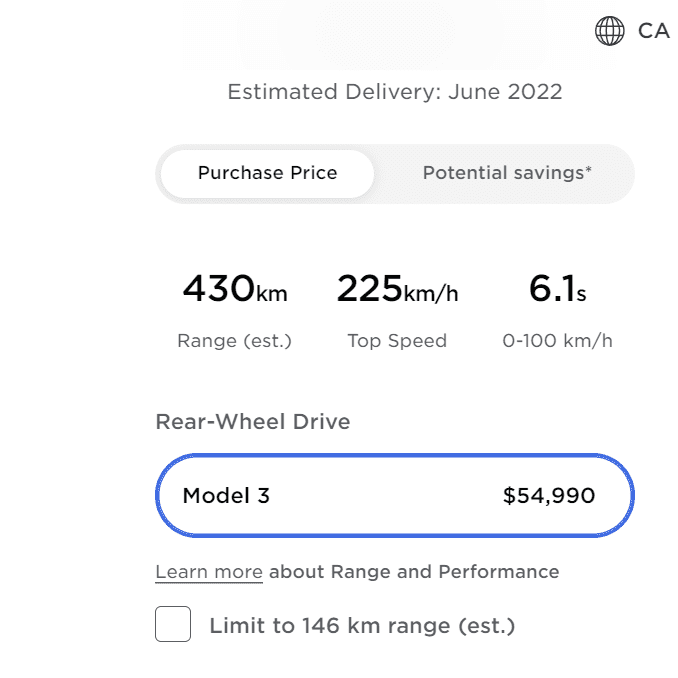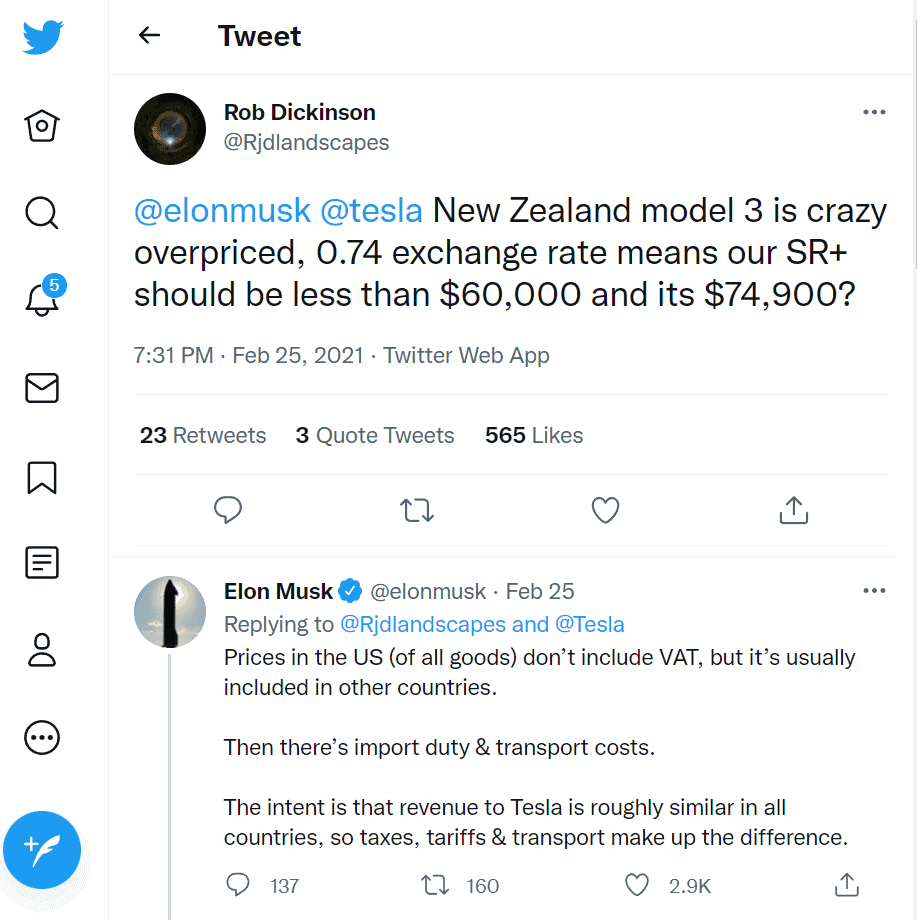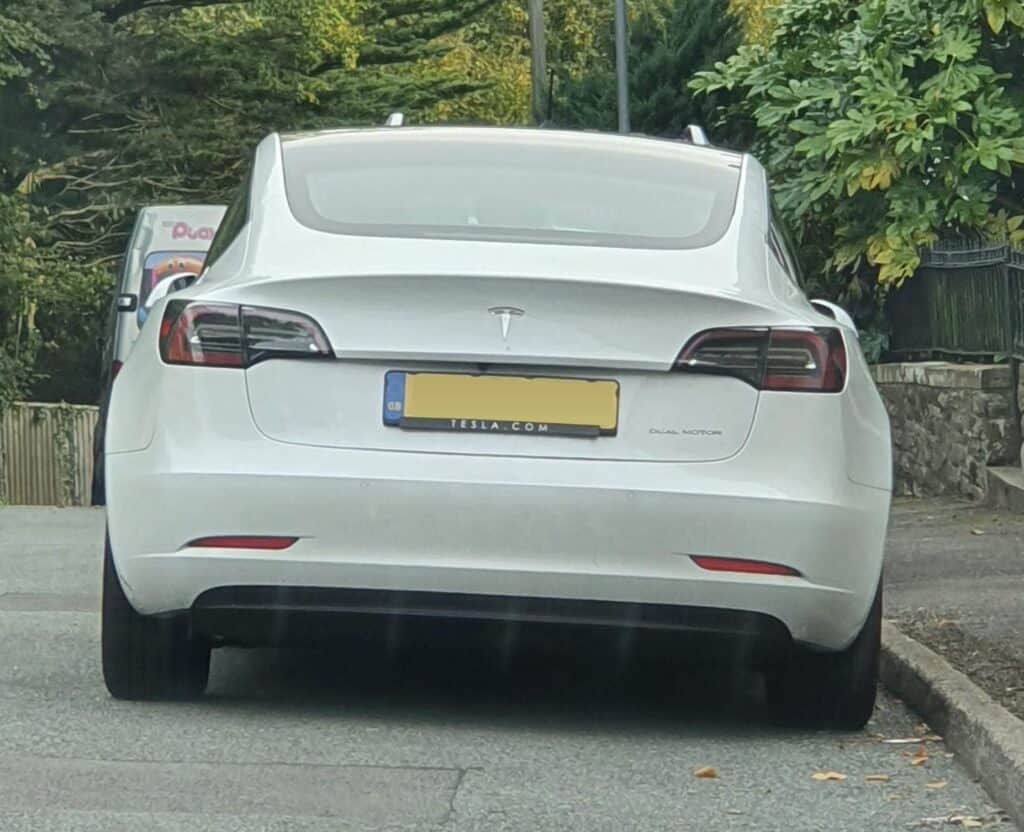Canadian Tesla fans, not to mention those in other countries around the world, have been somewhat dismayed to find that the prices they are paying for Tesla cars is far higher than those in the US. The discrepancies are actually quite shocking when you compare direct exchange rates. But why is that if you want to buy a Tesla in Canada, New Zealand or Australia, the entire experience gets a lot more expensive?
This is the core question of today’s blog where we dive in and look at the different marketplaces and try to understand why the prices are quite so different.
Background: The Price Differences

At the time of writing, we checked the US, Canadian and New Zealand Tesla websites to see the price differences in the Tesla Model 3 Standard Range Plus model. What is interesting is that there is certainly a price difference in the purchase price, but things also get quite interesting when you factor in the savings element to the equation.
| Country | Local Purchase Price | Purchase Price in USD |
| United States | $43,990 | $43,990 |
| Canada | CA$54,990 | $44,406 |
| New Zealand | NZ$66,900 | $47,969 |
From this we can see that there is definitely a price difference, but in fact it’s the poor New Zealanders who are getting a worse deal overall paying much more. Of course, they’re all doing better than the poor Tesla fans in the UK, where a Model 3 Standard Range Plus costs £40,990, or $56,401 in USD. The main advantage in the UK is that they can expect faster deliveries compared to either the US or Canada, at least that’s according to Tesla.com in each territory mentioned above.
What is with the price discrepancy between different territories? Elon Musk himself chimed in on the subject when a somewhat disgruntled New Zealand buyer discovered a huge gap in price between the US and New Zealand Model 3 Standard Range Plus, the same model we discussed further above. We’ll examine his reaction in the next section.
Elon Musk Tries to Explain

So when encountering an irate tweet from Rob Dickinson, a buyer in New Zealand, how did Elon Musk attempt to explain the difference in price between the two cars? The tweet was sent on February 25, 2021, when the Model 3 SR+ cost NZ$74,900, even more than it does at the time of writing this article. That translates to about $53,744. At the same time, the Model 3 SR+ in the US was priced at $36,990, which is also quite a lot lower than it is now.
“New Zealand model 3 is crazy overpriced, 0.74 exchange rate means our SR+ should be less than $60,000 and it’s $74,900?”
Rob Dickinson, Twitter, February 25 2021
The prices there are in New Zealand dollars. He also accompanied the tweet with screenshots showing the price difference between the two markets.
Elon Musk being the pretty stand-up kind of Twitter guy that he is, did respond to Dickinson’s concerns and pointed out that price differences between the US and countries like Canada, Australia and New Zealand are mostly down to VAT — Value Added Tax. Musk further pointed out that Tesla’s pricing strategy was designed to ensure that revenue from every sold in international markets was the same, and that means taking into account local tariffs, taxes and other expenses.
Musk said,
“Prices in the US (of all goods) don’t include VAT, but it’s usually included in other countries. Then there’s import duty & transport costs. The intent is that revenue to Tesla is roughly similar in all countries, so taxes, tariffs & transport make up the difference.”
Elon Musk, Twitter, February 25 2021
This might explain why there is a difference between the territories mentioned above. In the UK, for example, VAT is 20 percent, whereas in Canada it is only 5 percent. Beyond that, transporting from a manufacturing plant in the US to Canada is logistically a lot simpler than it is to either the UK, New Zealand or Australia.
Furthermore, Tesla units manufactured for the UK, New Zealand or Australia markets have to be made with the steering wheel and driver cockpit on the right-hand side because all three of those territories are ones where people drive on the left of the road.

That creates complexity in the production chain, even though there are many markets where driving on the left is also the norm, including Elon Musk’s native South Africa, India, Hong Kong, Japan and others.
Canada aligns with the US by driving on the right, so that makes Canadian models cheaper in a way. Things might change for people in the UK if and when the planned new gigafactory in Coventry is completed and opened. With batteries made locally, it could see a reduction in costs for Tesla units, but that’s a story for a future date.
What is Canada’s Tesla “Compliance Car”?
Another interesting aspect to this story is the added feature of Canada’s so-called “compliance car.” When this model was first announced, it’s price was within CA$45,000 (around $36,000) but at the time of writing the special entry-level compliance Model 3 was priced at CA$46,389, but that’s still a decent rate, of course.
What made the compliance model different? And how did it come about just in Canada and not in the beleaguered UK market? The answer can be found in Canada’s unique iZEV program.
What is the iZEV program?
The term iZEV stands for Zero-Emission Vehicles, and it’s a program launched back in 2019 as a way to encourage Canadian citizens to become early adopters of green vehicles. It’s not dissimilar in its function to the electric car grant scheme in the UK or the federal grants given in the US to stimulate EV sales. The idea is to provide some kind of subsidy that will make the price of EVs more competitive and more in line with those of combustion engine cars.
A number of vehicles qualify for the iZEV program, which provides financial incentives for people to either purchase an EV or to take out a 48-month lease. For those with a battery size below 15kWh, the financial incentive was CA$2,500 and for those with a battery capacity that exceeded 15kWh it doubled to CA$5,000.
It sounds great but one obvious criticism of the idea is that OEMs such as Tesla could just jack up the price and get the incentive as well as the profit. It’s a problem that has occurred with other government subsidizing schemes past and present, after all. Fortunately, there is an important caveat that prevents this issue, which is that the subsidy only applies to vehicles that are priced at CA$45,000 or less, which comes to about $36,000 as mentioned above.
How Does the Model 3 Figure into the Scheme?
In order to make the Model 3 qualify for this — to make it “compliant” — there had to be changes made. Most notably, the total range on Canada’s compliance Model 3 is significantly lower than a regular Model 3.
Above we compared the prices of a Model 3 with the Standard Range Plus trim level, which were priced as stated in the table. For that price, however, you get a range of about 262 miles. The compliance model, however, has its range limited to just 93 miles.
That obviously makes a big difference. The price comes down a heck of a lot, but can one really accept such a reduction in range? A range of just 93 miles makes it even lower in range than the old Nissan Leaf models from almost a decade ago. What’s more, this limited range has to contend with the wild’s of the Canadian winter, which could make the range even more limited.
Perhaps more interesting is that this special Canadian Model 3 has its range limited by special measure by Tesla. What we mean is that the battery is physically the same, but software prohibits many of its cells from working, which artificially reduces the range.
Could this spurn a whole underground movement of compliance Tesla “unlocking” in Canada? Even at CA$45,000 the compliance Tesla Model 3 remains an expensive purchase with a range of just 93 miles (151km).
Will Costs Come Down?
As technology improves, it can be expected that prices in non-US territories should come down, especially as Tesla continues its aggressive and strategic global expansion to build various manufacturing plants in other countries. It should help to ease the supply chain costs and ensure that more markets, including the US can enjoy a cheaper EV cost. There’s also the talked-about Model 2 to look forward to, which is supposed to bring cheaper EVs a big step closer to reality.